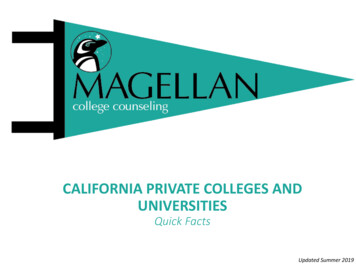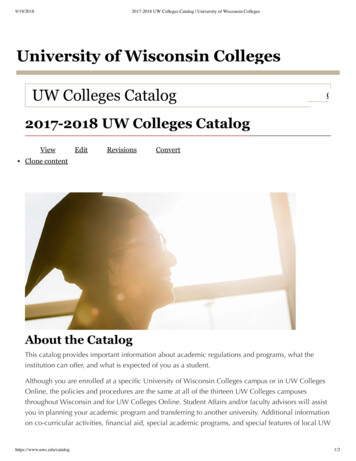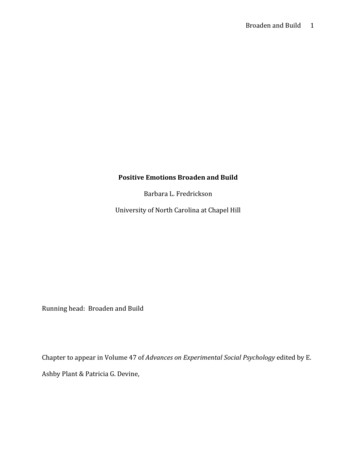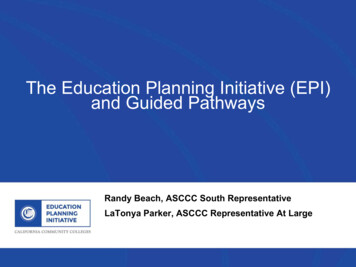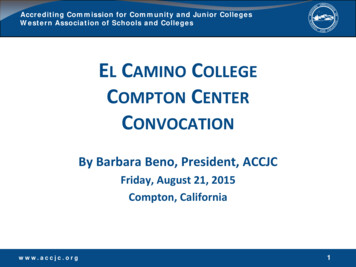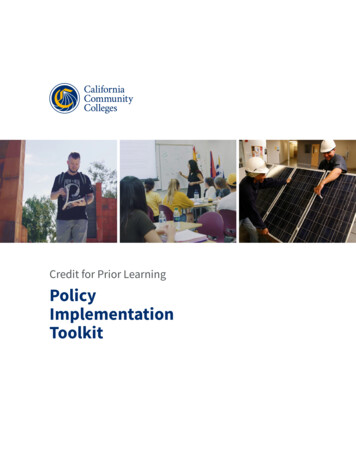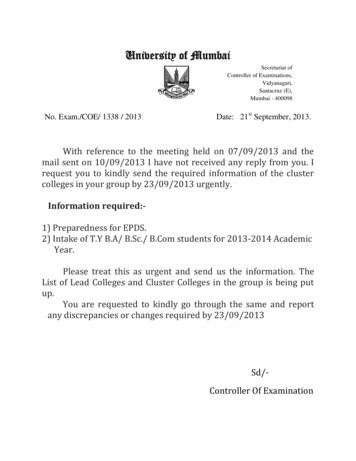
Transcription
What Happens When Colleges Broaden Accessto Transfer-Level Courses?Evidence from California’s Community CollegesTechnical AppendicesCONTENTSAppendix A. College ProfilesAppendix B. Additional Insights from our InterviewsAppendix C. Data and MethodsAppendix D. Caveat and LimitationsAppendix E. Figures and TablesMarisol Cuellar Mejia, Olga Rodriguez, and Hans Johnsonwith research support from Sergio Sanchez and Bonnie BrooksSupported with funding from the California Acceleration Project and the Sutton Family Fund
Appendix A. College ProfilesIn this appendix, we summarize how a group of colleges implemented placement and curricular reforms acrossthe state in English and math. Because the increase in access at these colleges is closer to what we expect to seeafter full implementation, these colleges provide an early example of what we might expect as more collegesincrease access.Implementation of placement and curricular reforms in EnglishAt the College of San Mateo, the percent of first-time English students gaining direct access to transfer-levelEnglish increased dramatically from 38% to 94% between 2015 and 2018 (Table E4, Technical Appendix E). Thechanges in access were primarily driven by a new multiple measures policy which placed students into theEnglish sequence using overall high school GPA, English grades, and other standardized test scores (e.g.Accuplacer, SAT, ACT, AP). The college was already offering an English 105 course, an enhanced collegecomposition course for students who needed additional support, particularly with critical reading skills. While thecollege has experienced success with the enhanced course, they feel “there is still room for growth” and recognizethat their college composition courses have begun to comprise a more academically heterogeneous population.Therefore, in spring 2019, the English Department began regularly meeting in Communities of Practice toimprove their teaching of composition, learn how to better integrate academic and non-academic skills (affectivedomain), and provide “just-in-time” remediation. For instance, one group is studying ways to improve studentengagement, while another is piloting new grading practices. Starting fall 2019 the college will no longer beoffering standalone remediation courses and will be looking at ways to enhance offerings in the writing center toprovide additional support for students with higher needs; they will have expanded instructional and studentservice support (e.g. – embedded tutors; intrusive counseling); they will have also begun cohorting studentsparticipating in the Promise Program. In addition to the implementation of the Promise Scholars and AB 705, thecollege is also working on Guided Pathways. The college is working to ensure that these initiatives are aligned toprovide students with instructional and student supports which together help to address students’ needs moreholistically.Over the past several years, Moreno Valley College has experienced significant gains in the share of first-timeEnglish students starting directly in college composition—from 19% to 87% between fall 2015 and fall 2018(Table E4, Technical Appendix E). In this timeframe, the college began to use GPA for placement into theEnglish sequence and began phasing out the lowest levels of the standalone remedial courses, such that only theone-level-below-transfer course—in an accelerated and hybrid model—is currently being offered. Still, theyfound that even with this shortened English pathway, many students in the accelerated courses were writing at thelevel of freshman composition. This led them to investigate the possibility of offering a co-requisite. In 2018, thecollege began offering a linked co-requisite course taught by the same instructor that focuses on three key areas:reading skills, writing skills, and affective domain/student success awareness skills. The idea was to providestudents with the academic and non-academic supports that will help them feel confident in their ability tosucceed. They found that the gains in access resulted in slight declines in pass rates, but overall, throughput wasmuch higher. Starting fall 2019, the college will no longer offer any standalone remediation and will place allstudents directly into a college composition course with or without support using high school GPA and the defaultplacement rules.Cuyamaca College was one of the first implementers of placement and co-requisite reforms in the state. Betweenfall 2015 and fall 2018, direct access to college composition nearly tripled, going from 31% of first-time EnglishPPIC.ORGTechnical Appendices What Happens When Colleges Broaden Access to Transfer-Level Courses?2
students to 88% (Table E4, Technical Appendix E). The broadened access was facilitated by a move toward adisjunctive multiple measures placement process that incorporated the use of self-reported GPA and by theintroduction of co-requisite English courses. In fall 2016, the college began to pilot a linked co-requisite courseand by fall 18 the Accuplacer placement test had been eliminated and all students were allowed to enroll directlyin college composition, some with co-requisite support. Similar to other colleges, the extra time provided by theco-requisite course is used to address students’ academic and non-academic needs. There is a perception that thegains in access and success in college composition are driven by the changes in structure which eliminate exitpoints and the resulting change in messaging: which now says “everybody is college ready.”Solano College was also one of the first implementers of developmental English reform in the state. With theadoption of a multiple measures placement practice and a co-requisite remediation option, the college saw accessto college composition increase from 33% in fall 2015 to 90% in fall 2018 (Table E4, Technical Appendix E).Early on, however, the gains in access were not as drastic because the college needed to manually clear studentsfor enrollment based on their high school records. Institutionalizing and automating the multiple measuresplacement helped streamline the process and get the college to where it is now. The college supports its moreacademically diverse student population in completing co-requisites by addressing the affective domain,providing just-in-time remediation, and by engaging more with reading and writing through more collaborativeactivities and conversations. Co-requisite courses also have the support of an embedded teaching apprentice. Still,there is an interest in collaborating with adult schools to support the small share of the student population whostruggles with basic literacy. As of fall 2019, the college only offers one section of remedial English; although nostudent is placed there, students would have the option to self-place in the remedial course; the default rules willbe used to place all students into the standalone or supported college composition course.Implementation of placement and curricular reforms in mathCuyamaca was the first college in the state to transform its math remediation approach. In fall 2016, Cuyamacalaunched its new Math Pathway program, with different math pathways for students pursuing different majors(Henson et al. 2017). After the transformation, the college began to use high school performance records togetherwith the placement test in a disjunctive multiple measures approach. The college also eliminated traditionalremedial courses below Intermediate Algebra and began allowing students to enroll in transfer-level statistics,pre-calculus and business calculus courses with co-requisite support. In the first year, direct enrollment totransfer-level math more than doubled from 26 percent to 57 percent. Cuyamaca also worked with its sistercollege and district on a new districtwide placement policy to resolve some operational challenges and increaseaccess. By the fall 2018, more than three quarters of Cuyamaca’s first time math students started in a transferlevel course (with or without co-requisite support). About 380 of these students successfully completed thecourse, which is substantially higher than the one-term throughput before the transformation started (163completions in fall 2015). The gains in throughput can be expected to grow even further in fall 2019 as the collegehas refined its placement process such that students will only see placements for the math course(s) that are mostrelevant to their major. Also, the reduction in below-transfer-level math courses will continue, as Cuyamaca willno longer offer pre-statistics and only a small number of intermediate algebra courses (approximately 5 sections).College of the Siskiyous also revamped their placement policies in fall 2016, permitting all students to enroll intransfer-level statistics. To support students, the college increased weekly contact hours from four hours to six byswitching one lecture hour to three lab hours. The additional lab hours allowed for embedded tutoring and groupcentered activities. This change in placement policies more than quadrupled the share of students enrollingdirectly in transfer-level math (or statistics) from 14 percent in 2015 to 65 percent in 2016 and 2017, and finally81 percent in 2018. During this same timeframe, one-year throughput rates increased from 17 percent in 2015 toPPIC.ORGTechnical Appendices What Happens When Colleges Broaden Access to Transfer-Level Courses?3
56 percent in 2017, and one-term throughput rates from 11 percent in 2015 to 49 percent in 2018. At Siskiyous,reforms in statistics were considered to be of foremost importance because most of their students enroll inprograms that do not require a transfer level math course beyond statistics or college algebra. For most studentsstatistics is the transfer level math they choose, with 67 percent of all first-time math students starting in statisticsin fall 2018.Los Medanos was the third college that modified its placement policies and curricular offerings in 2016. At LosMedanos, pre-requisite remediation has been decreasing over time while transfer-level offerings have been on therise as the college has refined its placement policies to incorporate self-reported GPA, prior coursework, andprogram of study. Specifically, the share of students enrolling directly in transfer-level math more than doubled(from 35 percent in 2015 to 74 percent in 2018). During this same timeframe, one-year throughput rates increasedfrom 35 percent in 2015 to 49 percent in 2017, and one-term throughput rates from 26 percent in 2015 to 47percent in 2018. Most of the gains reflect increased access to statistics (55 percent of first-time students started instatistics). In addition, placement policies have changed, such that students with a high school GPA of 2.8 andwho have completed beginning algebra qualify for standalone statistics and all students qualify for statistics withco-requisite support. Math faculty noted that being able to complete the math sequence faster makes the statisticsco-requisite option that much more attractive to students. Some students that are eligible for standalone statisticsopt to take the co-requisite “because [they] are a little afraid” of transfer-level math—an example of wherestudents may be prone to underplacement if given the option.Beginning in fall 2018, Foothill started allowing students to self-place into any entry-level transferable mathcourse, leading 91 percent of first-time math students to start in a transfer-level course up from 57 percent in fall2017. This change meant an increase of 90 percent in the number of first-time math students enrolling in statistics(from 224 to 425 students), and a 53 percent increase in pre-calculus (from 116 to 177). To support students inthese courses, Foothill provides peer tutors and supplemental instructors for statistics, and co-requisite support forpre-calculus. Course success rates suffered an 8-percentage point decline in statistics and 4-prcentage points inpre-calculus. But because of the large increases in access, the number of completions were up by 30 percent and28 percent respectively. Overall, one-term throughput increased from 29 percent in 2017 to 52 percent in 2018.At De Anza, 76 percent of first-time math students started in a transfer-level course, a 40-percentage pointincrease from the previous fall. Despite this significant increase in access, success rates in the statistics courseremained stable, leading to an increase in completions of about 400 students. De Anza did not offer co-requisitesupport. Overall, one-term throughput increased from 44 percent in 2017 to 62 percent in 2018.Appendix B. Additional insights from the interviewsScale of co-requisite offerings: The number of co-requisite sections can be limited because of supply or demandconstraints. For example, at Fullerton College enhanced course offerings had been partly limited because studentswanting to enroll needed to specifically request the course and because they were offered as pilot shadow courseswhile they sought to secure IGETC (Intersegmental General Education Transfer Curriculum) articulation. Thecourse received IGETC approval in May 2019 and beginning fall 2019, Fullerton will offer the enhanced coursefor 5 units. Starting fall 2019, students will be free to choose between the regular college composition course andthe enhanced college composition course. While the enhanced course will not be required for certain GPA bands,students will be encouraged to learn about their options, talk to a counselor and decide which course is best forPPIC.ORGTechnical Appendices What Happens When Colleges Broaden Access to Transfer-Level Courses?4
them. Given these changes, we can expect the enrollment in the Fullerton College enhanced course to increasesignificantly in fall 2019. On the other hand, Skyline College faced unexpectedly low student demand when theirenhanced English course was first offered (pre-2015). This happened because the first version of the enhancedcourse was identical to the regular English composition course, except that it was 5 credits instead of 3. Thecourse was dropped because the college “didn't want students to have to pay for credits that weren't really servingthem.” When Skyline College decided to bring that course back, the new enhanced course was redesigned so thatthe extra time could be used to incorporate an affective domain component and embedded student support.Finally, at several colleges, the growth of co-requisite offerings has been limited as a result of the placementresults themselves. In particular, we learned that placements in standalone transfer-level English were actuallyhigher than expected because of students’ strong grades in high school meant that co-requisite offerings were notnecessary.Non-credit coursework: As colleges spoke of significantly reducing or eliminating remediation, discussions ofthe use of non-credit courses emerged. 1 Colleges described using non-credit coursework in two ways: (1) toreplace the lowest levels of remedial sequences and (2) to mirror the remedial course sequence. Both approachesfocus on students who faculty believe need more than one year to reach transfer-level English and math. Mathdepartments for example spoke of turning arithmetic and pre-algebra courses into non-credit courses. At LosMedanos College we learned that there have also been discussions of making the co-requisite non-credit. One ofthe benefits of offering courses as non-credit is that students do not need to worry about the grades or tuition.However, if a student needs a certain number of units for a full load, taking non-credit courses would mean thatthey would need to take another credit course to meet this requirement. Still, it must be recognized that with theopen access mission being central to community colleges, providing basic skills courses using a non-credit optioncould be helpful for students who do not intend to obtain a degree or transfer to a four-year school. 2Appendix C. Data and MethodsOur quantitative approach utilizes student-level longitudinal data from the California Community CollegeChancellor’s Office Management Information System (COMIS). The dataset includes students enrolled across the114 community colleges that comprise the California Community College system, and includes information onstudent characteristics (race/ethnicity, gender, low income status), course-taking behavior, course elements (titleof course, levels below transfer level, credit status, transfer status and minimum/maximum number of credits),and student outcomes (grades, and credits earned). Data was also collected from an exhaustive scan of the latestcollege catalogs, websites, and other institutional documents. This process allowed us to identify which collegeswere offering co-requisite support.One college also mentioned the possibility of working with adult schools to better serve students with lower literacy levels.In our sample, about 75 percent of students who take math and English courses in the CCC identify their educational goal as a degree or transfer—this means that upto one-quarter of this group could conceivably benefit from non-credit basic skills.12PPIC.ORGTechnical Appendices What Happens When Colleges Broaden Access to Transfer-Level Courses?5
We are including in our analysis 109 colleges for English and 106 for math. For a small group of colleges wefound some inconsistencies between the MIS data and what we saw in college’s class schedules. We excluded thefollowing colleges from the analysis.English: L.A. Harbor, West L.A., L.A Trade-Tech, Southwest L.A., and Santa Monica.Math: L.A. Trade-Tech, Southwest L.A., West L.A., L.A. City, L.A. Harbor, East L.A., Mission, and Sequoias.Worth noting that this is a system-wide analysis, we are including information for all colleges with validinformation and calculating the same metric across colleges to identifying the group of colleges that saw thelargest increases in access to transfer-level English and math courses. We first, created cohorts of students basedon the term in which they took their first credit English/math course. Then, we calculated the share of first-timeEnglish/math students enrolling directly in college composition/ transfer-level math. Next, we used two criteria toidentify colleges that saw the largest increases in access to transfer-level courses. Specifically, we identifycolleges that saw an annual increase of more than 25 percent points in the share of first-time English/mathstudents starting directly in college composition/transfer-level math courses at some point between fall 2016 andfall 2018. Because this criterion misses colleges where the change happened more gradually, we also identifiedcolleges that registered a cumulative increase of 35 percentage points or higher between 2015 and 2018. It is safeto assume that these colleges engaged, in some degree or another, in placement reform.To inform our quantitative findings, we conducted semi-structured interviews with faculty, department chairs,division deans, and researchers at 19 colleges in the group that significantly broadened access to transfer-levelcourses and/or offered co-requisite support at scale. Specifically, during the spring 2019, we interviewed 24individuals that included 15 faculty, 7 division deans or department chairs, and 2 institutionalresearchers. Seventeen of the twenty-four individuals were involved with reforms in English and seven wereinvolved with reforms in math. All 19 colleges were using multiple measures for placement and either offering orplanning to offer co-requisite models. We spoke with each interviewee for about one hour over the phone.Interviewees were asked a variety of questions pertaining to their background; the math/English course sequenceofferings and motivation for offering certain sequence structures; how students assess, place and enroll into corequisite and transfer-level math and English courses; how and why co-requisite courses are structured in certainways; what is the pedagogy an curriculum like in co-requisite courses; key factors helping or hindering studentsuccess and equitable outcomes; the type of professional development provided; funding used to support reformefforts; what will placement and developmental education offerings look like in fall 2019 in response to AB 705;and how they see developmental education reforms aligning (or not) to guided pathways efforts. Open-endedquestions were used to facilitate the collection of information based on questions that do not restrict theparticipants’ opinions (Creswell and Plano Clark 2011). The data collection and data analysis were carried outsimultaneously to avoid the collection of repetitive and unfocused data (Merriam 1998). Specifically, after eachinterview was conducted, researchers debriefed, reviewed detailed data notes and audio recordings, and kept notesto capture reflections, emerging themes, and points that needed to be pursued further. This process of review andreflection informed all subsequent interviews. In this manner, data collected from each interview wascontinuously assessed and informed future interviews until data collection was complete. The data was alsoorganized and coded on a secure spreadsheet. This approach was used to come up with a number of patterns andthemes.PPIC.ORGTechnical Appendices What Happens When Colleges Broaden Access to Transfer-Level Courses?6
Appendix D. Caveats and Limitations1. The MIS database do not include data on placement, so we are unable to identify who was referred todevelopmental education or to transfer-level with or without co-requisite support. Neither do we do haveinformation of students’ high school performance measures (i.e. course taking, grades or GPA). Ouranalysis is based exclusively on course-taking behavior.2. A critical question is whether students who start in transfer-level courses with co-requisite support havebetter outcomes than those who start in traditional developmental sequences. Since we do not have highschool records or assessment and placement information, we cannot directly assess whether prioracademic ability drives our results.3. Even though our results do not include statistical controls, we believe our analysis uses the rightcomparison groups and counterfactuals. The evidence presented in this report is consistent or suggestiveof a positive and strong relationship between increases in access and increases in throughput; however, itis not sufficient to infer causality.4. The accuracy of our results relies on the accuracy with which colleges report their information to theChancellor’s Office. In a small group of colleges, we identified inconsistencies in terms of theirdevelopmental education offerings between what it was in the MIS data and the information presented incollege catalogues and class schedules (i.e., missing developmental courses). We excluded those collegesfrom our analysis. While we used various approaches to identify colleges with inconsistent data, it ispossible that we missed colleges where the data discrepancies were not as stark.5. In our calculations of access in math, we use any math or statistics courses flagged as transferable toeither a CSU or both UC and CSU, including courses that only transfer as electives and do not satisfy anygeneral education or major requirement. Ideally, we would only include those that satisfy generaleducation or major requirements the same way we do with college composition courses. Also, we areseparating statistics and other transferable math courses. Future analysis will separate transfer-level mathcourses between Statistics and Liberal Arts Math (SLAM) versus Business, Science, Technology,Engineering and Math (BSTEM), which is a better comparison because it aligns with the math pathwaysthat are increasingly being used at colleges across the state.6. Many colleges in our group that significantly broadened access offered some form of concurrent supportto help students to succeed under their new placement systems. Our focus in this report is on co-requisitemodels because we are not yet able to consistently identify and measure participation in other forms ofconcurrent support (e.g., writing labs, tutoring centers, supplemental instruction).7. We observe the year in which colleges saw a big jump in access; however, we do not have information onexactly when most colleges began to implement their placement policies. Similarly, we do not havecomplete details on the specific placement changes adopted (i.e., placement measures used, rules, etc.).8. This analysis sheds light on what happens when colleges significantly broaden access to transfer-levelcourses. However, given the fact that the state is moving from voluntary pockets of locally lead reformsto statewide mandated adoption, what will happen after AB 705 full implementation is unchartedterritory. The evidence presented in this report will be an important baseline for future examinations.PPIC.ORGTechnical Appendices What Happens When Colleges Broaden Access to Transfer-Level Courses?7
Appendix E. Table and FiguresTABLE EList of colleges that significantly broadened access to college composition and/or implemented co-requisite supportYear bigjump inaccessYear bigjump inaccessCOALINGA2016FOOTHILL2018LAS POSITAS2016FULLERTON2018MT. SAN JACINTO2016GROSSMONT2018PORTERVILLE2016MT. SAN ANTONIO2018SAN MATEO2016SACRAMENTO OS MEDANOS2017YUBA2018MERCED2017COSUMNES RIVERGradualMORENO VALLEY2017IRVINE VALLEYGradualNORCO2017L.A. CITYGradualREEDLEY2017SAN DIEGO CITYGradualRIVERSIDE2017SAN DIEGO MESAGradualAMERICAN 18COPPER MOUNTAIN2018CUYAMACA2018DE ANZA2018EAST L.A.2018FOLSOM LAKE2018PPIC.ORGTechnical Appendices What Happens When Colleges Broaden Access to Transfer-Level Courses?8
TABLE E2Share of first-time English students enrolling directly in college composition – colleges that significantly broadened accessversus rest of collegesColleges that significantly broadened access entsgoing directlyinto collegecompositionShare goinginto collegecomposition(%)Rest of colleges (70)First-timeEnglishstudentsgoing directlyinto collegecompositionFirst-timeEnglishstudentsShare goinginto ,6427994,52057,9616136928,249471,42119,07720TABLE E3Racial/ethnic distribution of first-time English students – colleges that significantly broadened access versus rest ofcolleges (%)2015Colleges thatsignificantlybroadened access2018Rest ofcollegesDifference(pp)Colleges thatsignificantlybroadenedaccessRest 6520233Asian American1311-21211-1African RGTechnical Appendices What Happens When Colleges Broaden Access to Transfer-Level Courses?9
TABLE E4Direct access to college composition among first-time English students and one-term throughput rateOne-term throughput rate (%)Share going directly in college 5201620172018Change2015-18(pp)MT. SAN ANTONIO17152295791210146149MORENO VALLEY19326787681423425541LOS MEDANOS24298788641923626243MT. SAN 596641SAN 136CITRUS484749100523535356733FOLSOM 627CABRILLO39414388492932336435SAN DIEGO MESA30476478482536455934AMERICAN 324736SKYLINE49769295463957646728EAST L.A.23253267441416213925SACRAMENTO CITY32354676432124305433IRVINE 177422728325731L.A. 395526VENTURA43516881383442525925SAN DIEGO 29LAS 3522TAFT38394775372628354620COSUMNES 32357L.A. VALLEY28355763342127414625SAN FRANCISCO 419MODESTO35344968332324334219College NamePPIC.ORGTechnical Appendices What Happens When Colleges Broaden Access to Transfer-Level Courses?10
One-term throughput rate (%)Share going directly in college 43457327PASADENA CITY43405675323533425722DE ANZA31353664322829315527SAN JOAQUIN DELTA42426574322728434720DIABLO 774303534445318FRESNO CITY31335161292122333817SAN DIEGO 5515CYPRESS33334561282525374722COPPER MOUNTAIN36353263272734285124EVERGREEN VALLEY28324456271924334323ALLAN HANCOCK46486973273237465018GOLDEN WEST46546272273440495622CONTRA 3517SADDLEBACK40384164243532345520IMPERIAL VALLEY24363347231423213521RIO 16L.A. PIERCE18173441231512263016SANTA BARBARA CITY59636382234952526112FEATHER RIVER57537279224542556116SANTA 69CERRO COSO27364444171822302911L
Los Medanos was the third college that modified its placement policies and curricular offerings in 2016. At Los Medanos, pre-requisite remediation has been decreasing over time while transfer-level offerings have been on the rise as the college has refined its placement policies to incorporate self-reported GPA, prior coursework, and
